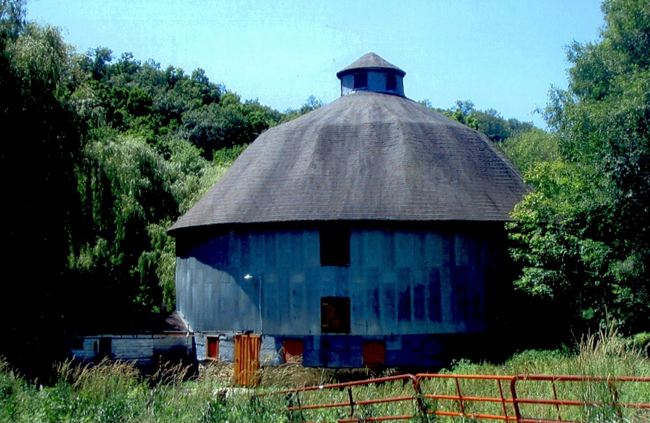Round Barns of Vernon County

Vernon County currently has more round barns than any other county in Wisconsin. It is thought that the whole state Wisconsin had up to 215 round barns at one time. As of 2019, there are 10 still standing in Vernon County, and one newly built. To the tour!
History of the Round Barns
Kevin and Patsy Alderson wrote and illustrated Barns without Corners about the round barns of Vernon County. You can see them discuss the history of round barns in this McIntosh Memorial Library video "Conversations:History of Round Barns in Vernon County".David Macasaet's film The Round Barns of Vernon County is available on vimeo. You can read more about David and the Round Barns on his web site.
It is believed that the first round barn, made of stone, was built in the U.S. in Hancock, Massachusetts, in 1826 by the Shakers. This barn still stands. The Shakers believed that evil spirits could not hide inside the round shape.
However, these barns were also practical. They were wind resistant, those made of wood were less expensive to build than rectangular barns, and they allowed for more efficient feeding of livestock. Cows and horses faced the center where feed and silage were kept in the circular silo. The silo also helped to support the roof.
Round barns required less building material since long supporting timbers were not needed. Some round barns were also constructed of tile or, later, sheet metal. Most were built from the 1880's to the 1930's.
Some early "round" barns were actually 8- or 9-sided. The first one of this kind is believed to have been built in Indiana in 1874. At one time, Indiana had about 226 round barns although only 8 are standing today. In 1889, University of Wisconsin professor of agricultural physics Franklin H. King designed a true round barn around a true round silo for his brother in Walworth County, Wisconsin.
In the 1930's, round barns became impractical for use in the dairy industry as farms were being electrified and milking pipelines were being installed in conventional barns. Round barns were not conducive to the installation of linear pipelines and barn cleaners; however, some round barn owners did have custom-made pipelines installed despite the more expensive cost. Also, milk houses, used to store bulk milk tanks, had to be added to round barns. And instead of loose hay, machinery was being used to make square bales out of cut hay, and square bales were stored more easily in rectangular barns.
In Vernon County, remaining round barns are mostly used today for storage purposes or for housing horses, calves, heifers, or dry cows. Some Amish farmers use them for milking since they do not use mechanization.
On to the tour!
*Information on individual barns is from the revised Round Barns of Vernon County, Wisconsin; A Circle Tour
by Gail Curry Fish, Wava G. Haney, and June Zalewski Pedretti, 2004.

 MENU
MENU